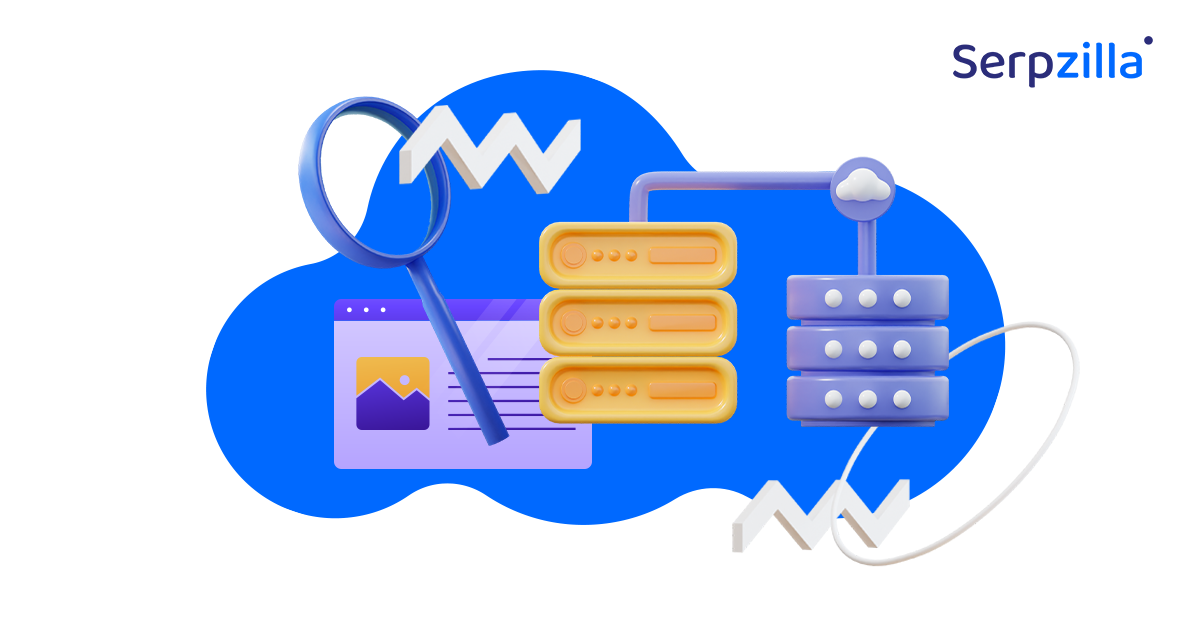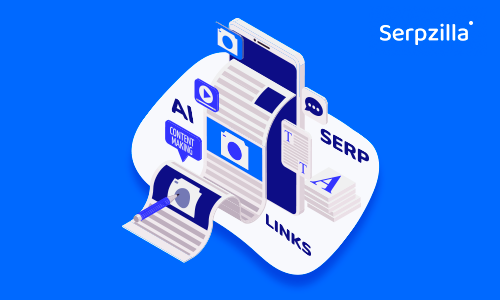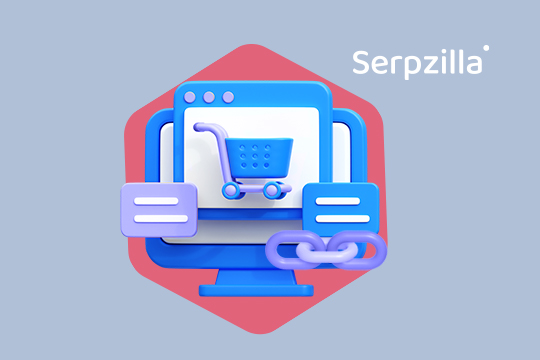Search in 2026 is more nuanced than ever. People are getting AI-curated answers from Google Overviews, Perplexity, and Gemini, and scrolling through ten blue links is no longer the most obvious option. The question is: how do you make sure your site gets included in AI summaries?
The answer is structured data for AI. Adding schema markup gives your content a fighting chance in AI-driven results. Read on to learn how schema markup optimization for AI platforms works in 2026.
What Is Structured Data in AI Search?
Structured data is basically content with a label attached. You might simply write “noise-cancelling headphones,” or add extra code that tells machines much more. They’ll see what the product and the brand are, what the price is, and even what people think about it.
Unstructured data doesn’t follow a predefined model or format. Plain text, images, or video are great for humans but messy for machines. AI models need structured and labeled data so they can parse, categorize, and use it in answers. Without it, your content might be invisible in AI Overviews.
Here’s a simple example:
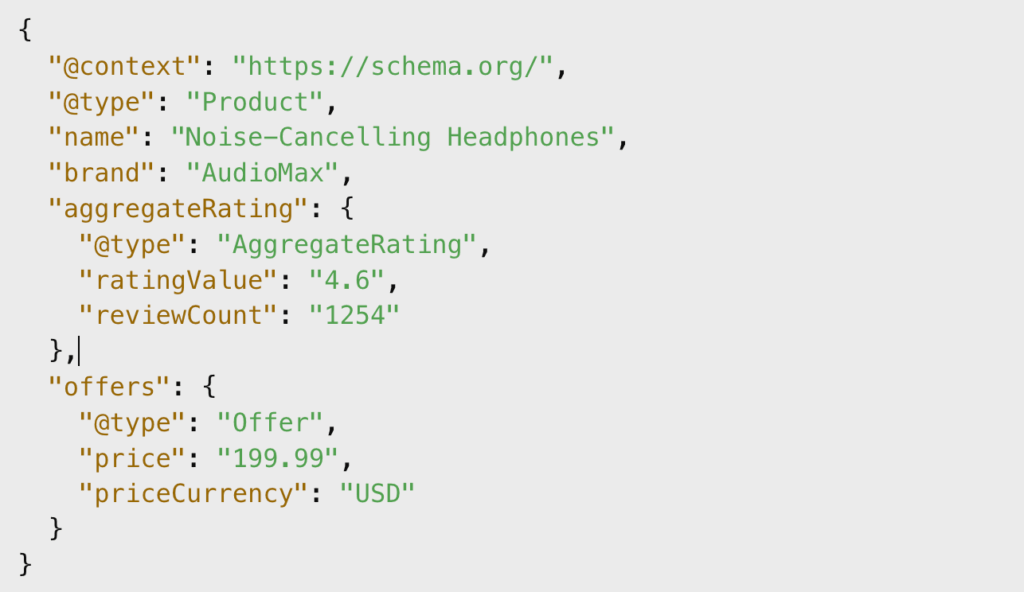
This short snippet already says more to an AI crawler than a 500-word product description without markup.
The Role of Schema Markup in AI Search Visibility
Schema markup acts like subtitles for your content. Thanks to it, AI easily understands the page logic, storyline, context, and relationships. Without it, you’re basically leaving the system to fill in the blanks on its own, and that rarely plays out the way you’d want.
How structured data improves AI search results
- It removes ambiguity. “Apple” the fruit or “Apple” the brand? Schema makes it clear.
- It connects entities. It helps AI link your page to bigger knowledge graphs.
- It improves presentation. Reviews, FAQs, ratings, and snippets show up more often in AI-generated answers.
Moving from keywords to semantic understanding
The improvements in context, entity connections, and presentation all point to a bigger shift: search engines are moving away from keywords and toward meaning. Schema is what allows for this gap to close.

Think of the path like this: Keyword → Entity → Knowledge Graph → AI Answer. When you add schema, you’re guiding AI along this clear path.
FAQ schema and its impact on AI search mentions
FAQ schema is probably the easiest way to appear in AI search results. AI Overviews love structured Q&A content types because they mirror how people ask questions in real life. Instead of parsing long text, the model can pull a ready-to-consume answer right away.
Just take a look at these examples:
| No schema | With FAQ schema |
| Eggs pack a solid nutritional punch, providing roughly 6 grams of protein each. | Q: How many grams of protein are in one egg? A: One average egg has ~6 grams of protein. |
| Travel rules change depending on your passport and destination. | Q: Do I need a visa to visit Japan from Canada? A: Canadian tourists can visit Japan visa-free for up to 90 days. |
| Banks promote APR and APY but they measure different things. | Q: What’s the difference between APR and APY? A: APR is yearly interest on loans; APY is yearly yield on savings, including compounding. |
In the right column with markup, you get scannable entries AI can lift almost word-for-word. That’s a simple but clear illustration of FAQ schema impact on ai search mention frequency.
Google AI Overviews and Structured Data Guidance
After seeing how FAQ schema helps you appear in AI summaries, it’s worth zooming out to what Google itself says about structured data in this new search environment. In every update and developer note since AI Overviews launched, Google keeps stressing the same thing: schema markup still matters — maybe more than ever.
Here’s what Google highlights in its official structured data guidance:
- Use JSON-LD as your preferred format: it’s cleaner and easier for AI to parse.
- Match every schema type to the real content on the page. Don’t tag things that aren’t there.
- Regularly test using Google’s Rich Results Test or the Schema.org validator to ensure your markup remains eligible.
In other words, Google’s stance on Google AI Overviews structured data guidance is simple: structured data is the foundation of how AI understands and surfaces information. Don’t skip it if you don’t want to lose SERP advantage.
Types of Schema That Influence AI Search
Different schema types open different opportunities in AI search. Here’s a closer look at the ones that work best in 2026:
FAQ schema for Q&A visibility
As we’ve already mentioned, FAQ schema lets you mark up common questions and answers so AI can put them directly into results. This is especially effective for the “how,” “what,” or “why” questions. Adding FAQ schema increases your chances of appearing in Google AI Overviews and Perplexity answers because it mirrors how people naturally search. A total must-do!
Example JSON-LD:
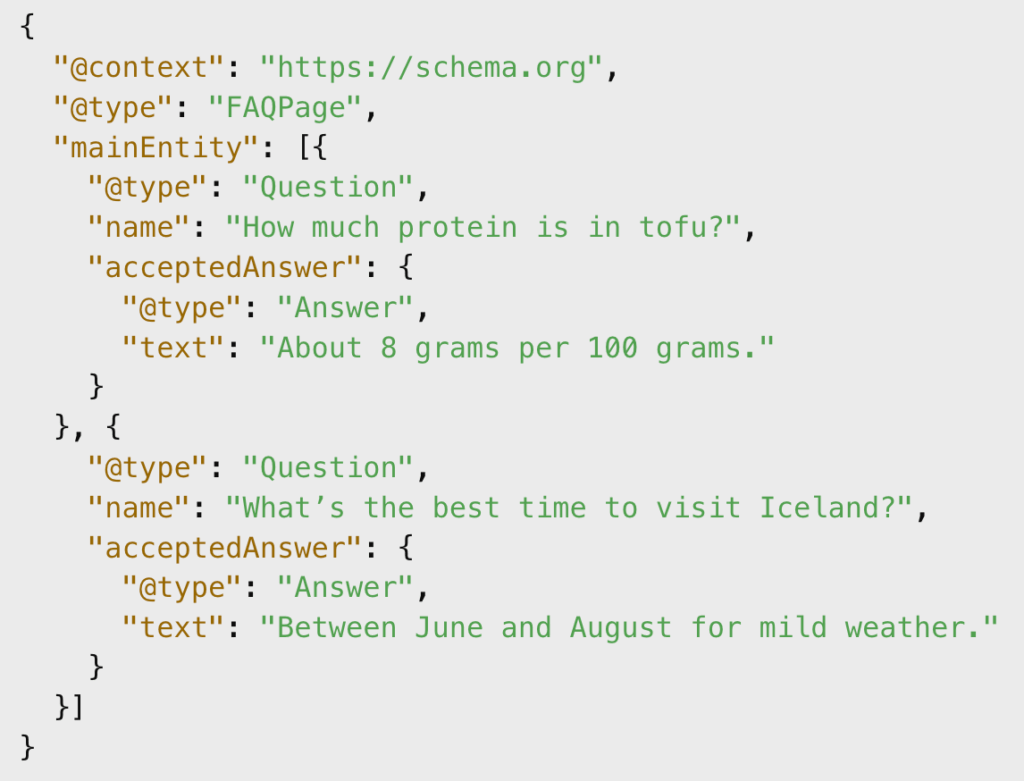
Product schema for eCommerce focus
Product schema reflects key product details like name, brand, price, availability, and reviews. For eCommerce businesses, this one is non-negotiable. With proper markup, AI can compare your product to competitors, display price ranges, or highlight shipping availability, all of which can drive clicks and conversions.
Example JSON-LD:

Review schema for ratings in AI answers
Review schema basically conveys customer sentiment. It adds ratings, stars, and review counts to your listings. AI models use this review data to determine trustworthiness. A product with a review schema is far more likely to be surfaced than a similar product without it.
Example JSON-LD:

Organization and author schema for EEAT signals
Schema for organizations and authors shows that your content comes from a credible source. It’s like a digital signature: logos, social links, and short bios tell search engines and users there’s a real voice and organization behind the words. These signals support Google’s EEAT (Experience, Expertise, Authoritativeness, Trustworthiness) framework, which influences whether AI highlights your content.
Example JSON-LD:

Advanced: Video, image, and how-to schema for visual AI snippets
Advanced markup types like VideoObject, ImageObject, and HowTo schema are great for multimodal search. They let AI feature your videos in tutorials, your images in explanations, or your step-by-step guides in answer boxes. As AI Overviews become more visual, this markup will separate generic text content from engaging, multi-format answers.
Example JSON-LD:
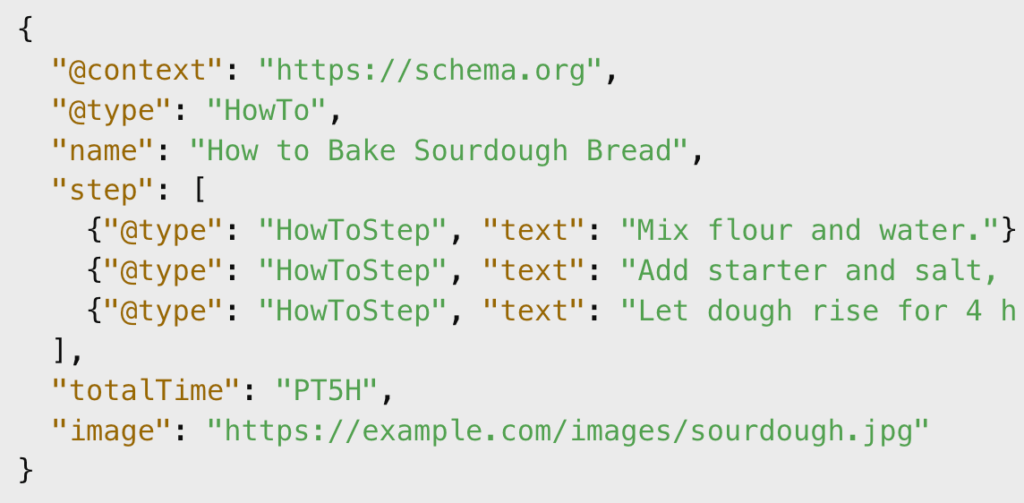
Tools for Schema Markup and AI-Driven SEO
You don’t have to hand-code everything when it comes to schema markup. Here’s a list of simple and effective tools you can try:
Schema.org
This is an official, free library for schema types and properties. It’s the best choice for understanding which schema fits your content and learning the syntax straight from the source.
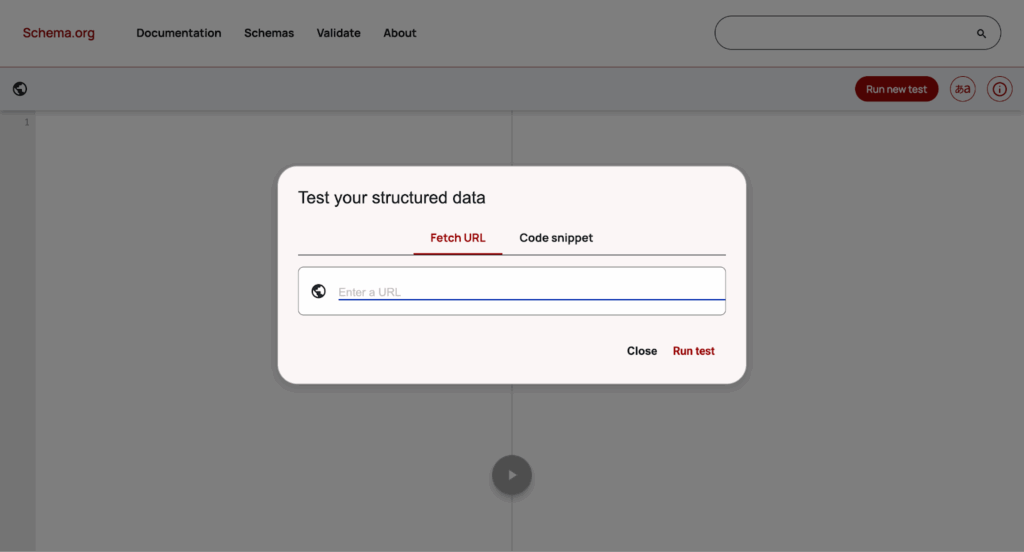
Easily test your data.
Google Rich Results Test
As you’ve already seen, this is the go-to validator to check whether your markup is eligible for rich results and AI-friendly displays. Use it every time you deploy new pages to ensure nothing breaks.

Simply enter your URL in the field.
Serpzilla
This platform is perfect for scaling beyond markup. Serpzilla automates link placement to strengthen your structured pages’ authority, pairing schema optimization with contextual backlinks to improve visibility in both SEO and AI-driven results.
Pro tip: You can connect Serpzilla’s campaign planning with AI tools like ChatGPT or Jasper to identify link opportunities that match your schema-optimized pages. For example, prompt AI to analyze your structured data for topical clusters, then use Serpzilla to place contextual links on authoritative domains in those same clusters.
Implementation Guide: How to Optimize for AI Search
Step 1. Audit your current schema
Figure out what state your pages are in. Use tools like Sitebulb or Google Search Console’s Enhancements section to find pages missing structured data or containing errors. Pay extra attention to your high-traffic and top-converting pages. They’re the ones that’ll gain the most from a bit of cleanup and properly labeled data.
Pro tip: Export schema data into a spreadsheet and tag each page by schema type (e.g., Product, FAQ, Article). This makes it easier to plan updates.
Step 2. Generate markup with tools
Once you know what’s missing, use generators or AI prompts to create JSON-LD quickly. Schema.org or even ChatGPT can build accurate templates.
Example prompt: “Generate JSON-LD product schema for a waterproof smartwatch priced at $129 with 4.6 rating.”
Remember: AI tools save hours when you’re updating hundreds of pages, but always double-check the output for property accuracy.
Step 3. Add JSON-LD to your pages
Add the JSON-LD markup where search engines can easily find it, ideally through your site’s CMS or tag manager. If you manage a larger site, you might want to use a global script or template so updates apply automatically across pages.
For smaller sites, you can paste the code directly into the page HTML. Just make sure it stays separate from your design elements for easier maintenance.
Pro tip: Keep schema separate from page design. If your CMS allows JSON-LD blocks, store them in a dedicated section for easy updates.
Step 4. Validate and test
Never skip validation. Use Google’s Rich Results Test to confirm your schema is error-free and eligible for enhanced results. For deeper checks, use Schema.org’s validator or structured data testing tools inside Search Console.
Invalid schema can quietly break your eligibility for AI and rich result visibility, even if your content quality is high. So don’t skip this step.
Step 5. Track and refine AI visibility
After implementation, track how AI crawlers interact with your pages. Use tools like Semrush’s SERP Features report or Ahrefs’ Site Explorer to see whether your structured pages start appearing in AI Overviews or other SERP features.
Pro tip: Track impressions and clicks specifically for pages with schema markup versus those without it. Over a few weeks, you’ll likely see a measurable visibility gap.
Measuring Impact: Structured Data in AI Search Ranking
How do you know if schema’s paying off? Look for the following signs:
- Are your pages cited in AI Overviews? If your structured data is strong enough, you’ll eventually see it referenced directly by AI-generated summaries.
- Did your CTR improve even if rankings stayed the same? A higher click-through rate means your schema-enhanced snippets are standing out more in search results.
- Are schema-rich pages outranking plain ones? Compare performance between marked-up and non-marked pages to see if structured data improves competitiveness.
- Do FAQ or HowTo snippets bring more engagement? Track bounce rates and time on page. Structured content often keeps users reading longer.
That’s the impact of structured data on AI-driven SEO in action, and it’s also how structured data improves AI search ranking.
Common Schema Markup Pitfalls and How to Avoid Them
Even experienced SEO pros can trip up when working with schema markup. Here are some of the most common mistakes with simple ways to avoid them effectively.
⚠️ Over-optimization
Adding every schema type just clutters things and makes your markup harder to maintain. Overloading a page with unnecessary or irrelevant schema can confuse crawlers and reduce your eligibility for rich results.
Fix: Only use schema that reflects real page content. Keep it lean and relevant.
⚠️ Wrong schema type
Applying Product schema to a service page is a sure way to mess up your markup.
Fix: Cross-check against Schema.org before implementing.
⚠️ Missing updates
Using outdated properties that Google no longer supports will quickly make your markup irrelevant and invisible to search engines, costing you eligibility for AI features.
Fix: Review your markup quarterly and update based on Schema.org changes.
⚠️ No multilingual support
Schema only in English when your site targets other regions can confuse search engines and limit your global reach. Multilingual audiences may not see localized snippets, and AI crawlers might misinterpret your content’s context or relevance.
Fix: Add the <inLanguage> property and localized schema versions.
Final Word: The Future of Schema in AI Search
Structured data won’t stay static — nothing really does in SEO. Expect hybrid markup that mixes schema with embeddings and context layers. Schema will increasingly describe not just what something is, but why it matters in context.
If you want to be ready, update often, watch Google’s guidelines, and think multimodal.
FAQ on Schema Markup
How does schema markup differ for AI crawlers vs. traditional search engines?
Traditional search indexes. AI crawlers interpret and synthesize. Schema helps them do it accurately.
Can unstructured data still appear in AI answers?
Sometimes, yes. But structured data makes you a reliable source rather than a lucky one.
What’s the role of knowledge graphs in AI-driven SEO?
They connect your content to entities (people, places, products, or concepts) and define how those entities relate to each other. Schema is what feeds those graphs, giving AI the context it needs to understand how your page fits into the broader web of information.
How do schema updates affect AI search visibility?
When Schema.org retires a property, unupdated markup may stop being read. That’s why you should always refresh it.
Which industries benefit most from AI-focused structured data?
eCommerce, healthcare, finance, and education benefit the most. These are the fields where accuracy and trust really matter.
Is JSON-LD always better than Microdata for AI optimization?
Yes, Google recommends JSON-LD for flexibility and ease of use.



